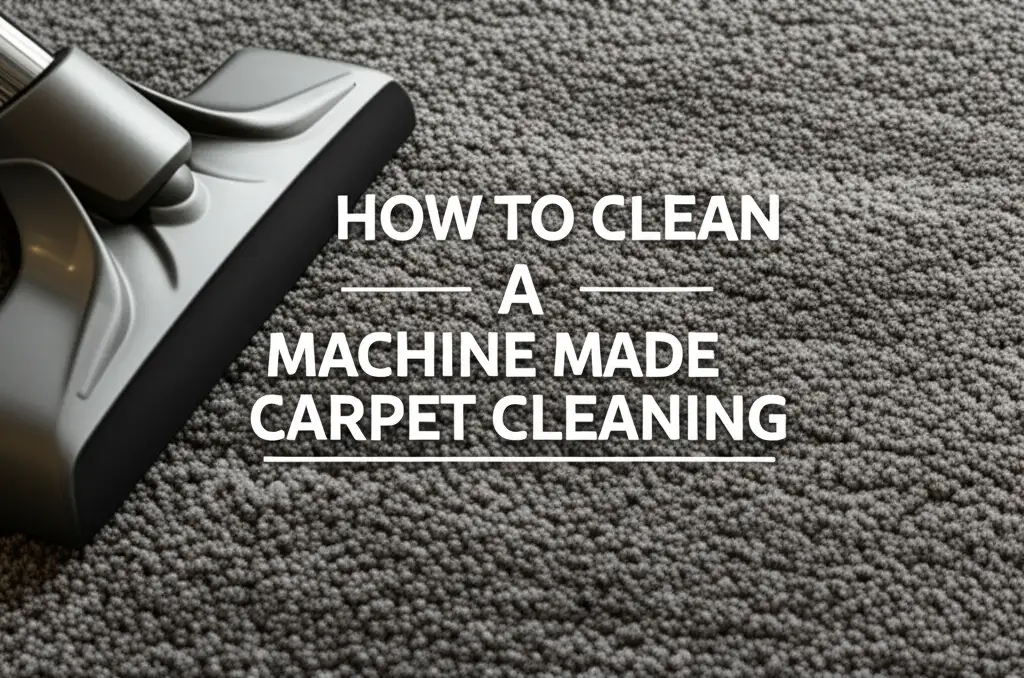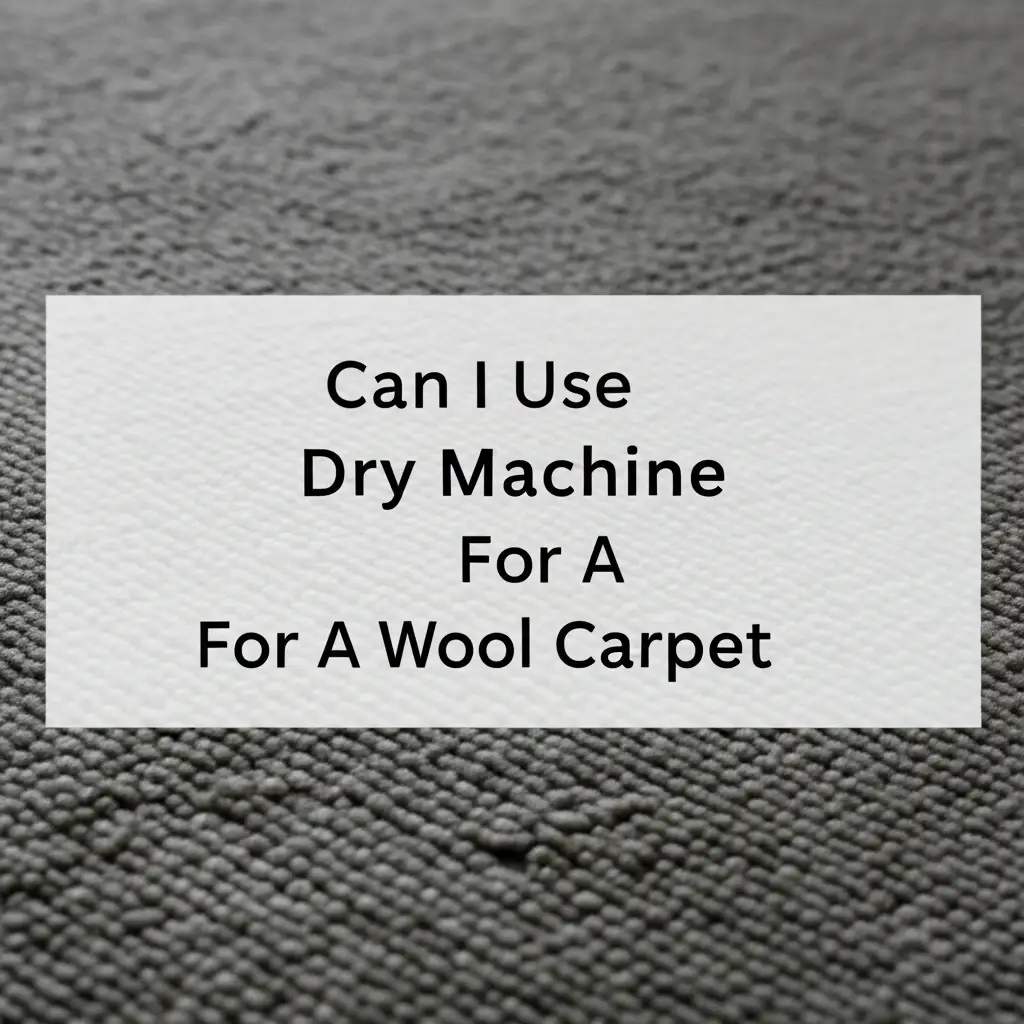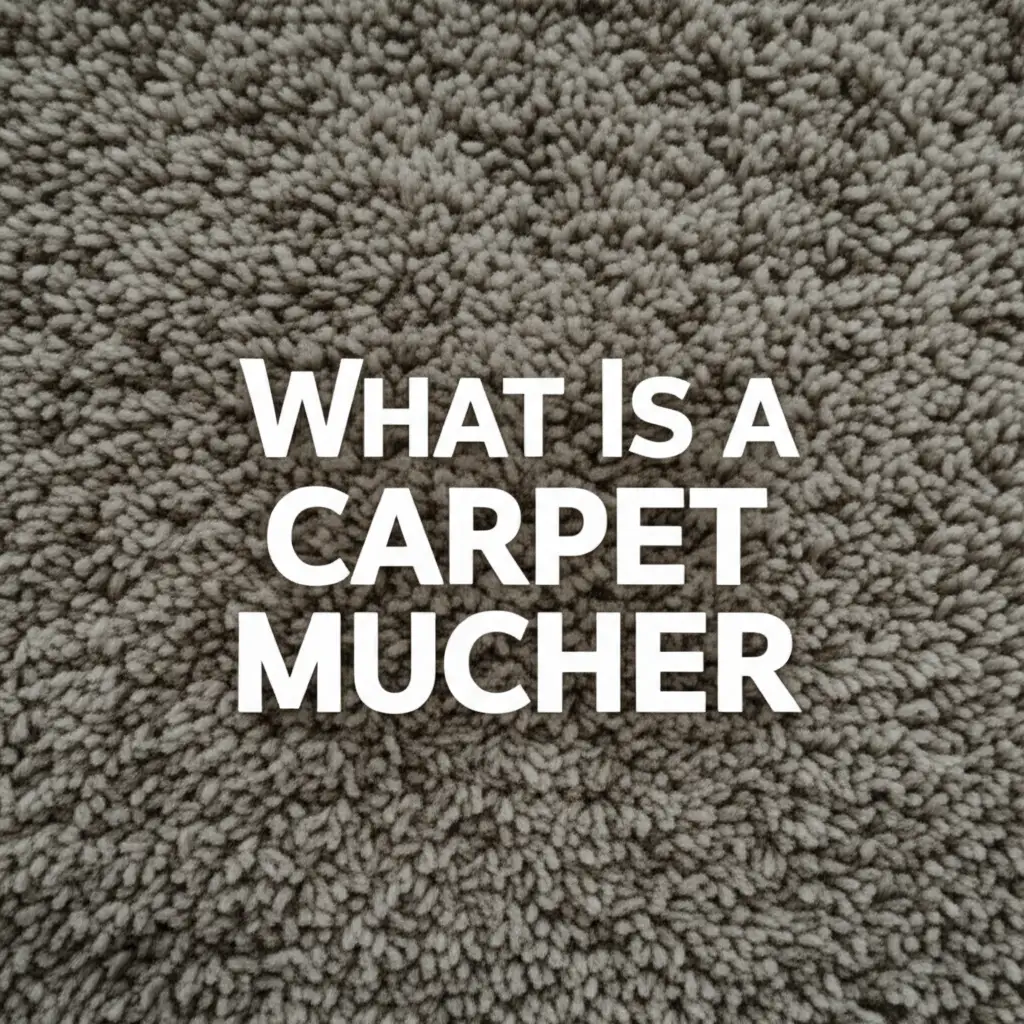· Tessa Winslow · Carpet Care · 16 min read
How To Clean A Machine Made Carpet Cleaning

Effective Machine-Made Carpet Cleaning: A Comprehensive Guide
Your home’s carpets see a lot of traffic. They collect dirt, dust, and spills daily. If you have machine-made carpets, keeping them clean is key for a fresh and healthy home. This guide shares the best ways to tackle machine-made carpet cleaning. We will explore essential steps, tools, and methods for a deep clean. This ensures your carpets stay looking their best.
This article will walk you through understanding machine-made carpets. It covers how to prepare them for cleaning. We will discuss choosing the right cleaning machines and solutions. You will learn a step-by-step cleaning process. We also cover stain removal, drying, and important care tips. By the end, you will know how to make your machine-made carpets truly clean.
Takeaway:
- Identify your carpet material before cleaning.
- Vacuum deeply to remove loose dirt.
- Choose a cleaning machine suitable for your carpet type.
- Always test cleaning solutions in a hidden spot.
- Dry carpets fully to stop mold growth.
To clean a machine-made carpet effectively, first understand its material. Then, vacuum thoroughly. Use a suitable carpet cleaning machine with a gentle solution. Apply the solution evenly, then extract it completely. Ensure the carpet dries fully to prevent mold.
Understanding Machine-Made Carpets
Machine-made carpets are common in many homes. They offer durability and a wide range of styles. These carpets are often made from synthetic fibers. Common materials include nylon, polyester, polypropylene (olefin), and acrylic. Each fiber type has different properties. These properties affect how you clean the carpet. Knowing your carpet material helps you choose the correct cleaning method.
Nylon carpets are strong and resist stains well. Polyester carpets feel soft and hold color beautifully. Polypropylene carpets are good for high-traffic areas. They resist water and fading. Acrylic carpets feel like wool. They resist moths and mildew. Your carpet label usually lists the materials. This information is vital for proper machine-made carpet cleaning.
These carpets are made using large weaving machines. This process creates a uniform look and strong construction. The dense loops or cut piles hold dirt and allergens. Regular cleaning removes these trapped particles. Deep cleaning restores the carpet’s appearance. It also improves indoor air quality. Understanding these carpets helps you provide the best care.
Machine-made carpets are designed to be tough. They handle daily wear well. Still, they need proper care to last. Different fibers react differently to heat and chemicals. For example, high heat can melt polypropylene. Strong solvents might damage dyes. Knowing your carpet’s fiber content protects it during cleaning. Always check the manufacturer’s care instructions.
Preparing Your Carpet for Effective Cleaning
Preparation is a key step in any deep cleaning process. Before you start machine-made carpet cleaning, you must prepare the area. This makes the cleaning process easier and more effective. Proper preparation prevents spreading dirt. It also protects your furniture. Do not skip these important first steps.
Start by removing all furniture from the carpeted area. If you cannot move heavy items, place plastic protectors under their legs. This stops moisture from transferring to the furniture. It also protects the carpet from rust stains. Moving furniture allows you to clean every part of the carpet. This ensures a uniform clean across the room.
Next, vacuum the carpet thoroughly. Use a powerful vacuum cleaner. Go over the entire area multiple times. Vacuum in different directions. This lifts stubborn dirt and debris from the carpet fibers. Pay close attention to high-traffic paths and edges. Loose dirt can turn into muddy residue when wet. A good vacuuming makes the deep clean more effective.
- Vacuuming Tips:
- Use a vacuum with strong suction.
- Pass over the same area several times.
- Overlap your vacuuming paths.
- Empty the vacuum bag or canister often.
After vacuuming, inspect the carpet for stains. Pre-treat any visible spots or heavily soiled areas. Use a suitable pre-treatment spray. Apply it directly to the stain. Let it sit for a few minutes. This breaks down the stain before the main cleaning. Pre-treating makes it easier for the machine to lift the dirt. This step is important for deep-set stains. For tough pet stains, consider specialized products designed to tackle those issues, which can be found in resources like how to clean carpet stains pets.
Choosing the Right Machine and Solutions
Selecting the correct cleaning machine and solutions is vital for successful machine-made carpet cleaning. The wrong choice can damage your carpet. It can also leave residue. Many types of carpet cleaning machines are available. Each works differently. Understand what your carpet needs before you buy or rent.
Hot water extraction cleaners, also called steam cleaners, are popular. These machines spray a hot cleaning solution into the carpet. They then immediately extract the dirty water. This method deeply cleans the carpet fibers. It removes dirt, allergens, and odors. Hot water extraction is effective for most machine-made synthetic carpets. You can learn more about how this type of cleaning works by reading how carpet cleaning works.
- Types of Cleaning Machines:
- Hot Water Extractors (Steam Cleaners): Best for deep cleaning synthetic carpets. They use hot water and cleaning solution.
- Dry Compound Cleaners: Use a powder that absorbs dirt. Good for delicate carpets or quick cleans.
- Spin Bonnet Cleaners: Use a rotating pad soaked in cleaning solution. They are good for surface cleaning.
When choosing a cleaning solution, look for products made for your carpet type. Many solutions are specific to synthetic fibers. Avoid harsh chemicals or bleaches. These can damage your carpet’s color or texture. Always use a low-foaming detergent. High-foaming solutions are hard to rinse out. They can leave sticky residue. This residue attracts new dirt quickly.
Always test your cleaning solution in a hidden area of the carpet. This could be under a couch or in a closet. Apply a small amount of the solution. Wait a few minutes. Then, blot it with a white cloth. Check for any color change or damage. If the carpet’s color transfers to the cloth, do not use that solution. This test prevents damage to your entire carpet.
Consider using an enzyme cleaner for pet accidents or strong odors. Enzymes break down organic matter. They remove the source of the smell. For very old carpets, you might wonder if cleaning makes a difference. Yes, deep cleaning can still greatly improve the look of an old carpet. More details on this can be found in articles like does cleaning 10 year old carpet work.
Step-by-Step Machine Cleaning Process
Once you have prepared your carpet and chosen your tools, you can begin the actual machine-made carpet cleaning. Follow these steps carefully for the best results. A systematic approach ensures a thorough and even clean. Do not rush this process.
First, fill the machine’s clean water tank. Add the recommended amount of carpet cleaning solution. Read the instructions on both your machine and the cleaning solution. Using too much solution can leave residue. Using too little might not clean effectively. Ensure the water is at the correct temperature if your machine has a heater. Hot water often improves cleaning power.
Start cleaning in a far corner of the room. Work your way towards the exit. This avoids walking on freshly cleaned areas. Move the machine slowly and steadily. For most machines, you push forward to spray the solution. Then, pull back to extract the dirty water. Overlap each pass slightly. This ensures no spots are missed. Make sure to cover the entire carpet surface.
- Cleaning Strokes:
- Apply solution on the forward pass.
- Extract on the backward pass.
- Overlap each pass by a few inches.
- Do not over-wet the carpet.
After applying and extracting the solution, consider a rinse pass. Empty the dirty water tank. Refill the clean water tank with plain hot water. Run the machine over the carpet again. This time, only spray clean water. This helps remove any remaining cleaning solution. Rinsing is important to prevent residue buildup. Residue makes carpets get dirty faster. This step also prevents stickiness.
Empty the dirty water tank often. You will be surprised how much dirt comes out. If the water looks extremely dirty, repeat the cleaning process. You can do this with either solution or just plain water. The goal is to get the water extracted from the carpet to look as clear as possible. This indicates that most of the dirt and residue are gone.
Handling Stains and Odors on Machine-Made Carpets
Stains and odors are common problems on carpets. They need specific attention during machine-made carpet cleaning. Simply running the machine over them might not be enough. Treating stains quickly and correctly prevents them from setting in. Odors, especially from pets, require deep treatment to be truly eliminated.
For fresh spills, act fast. Blot the spill immediately with a clean, white cloth. Do not rub, as this can spread the stain. It also pushes the substance deeper into the carpet fibers. Blot from the outside of the stain towards the center. This stops the stain from getting larger. Speed is important for preventing permanent marks.
For dried or stubborn stains, pre-treat them before machine cleaning. Use a specific stain remover for the type of stain. For example, enzyme cleaners work well on organic stains like food or pet urine. For oil-based stains, a degreasing agent might be needed. Apply the cleaner as directed. Let it sit for the recommended time. Then, gently agitate the area with a soft brush. For specific challenging stains, such as removing sticky food like cheese, specialized methods are often needed, as detailed in guides like how to clean cheese out of carpet.
- Stain Treatment Steps:
- Blot fresh spills immediately.
- Identify the stain type.
- Apply appropriate stain remover.
- Let it dwell, then gently agitate.
- Blot again to remove loosened stain.
Pet odors are often deep-seated. They come from urine soaking into the carpet backing and subfloor. After machine cleaning, sprinkle baking soda over the affected area. Let it sit for several hours, or even overnight. Baking soda absorbs odors. Then, vacuum it up thoroughly. For severe odors, you might need to use commercial pet odor eliminators. These products contain enzymes that break down the odor-causing molecules.
Remember that thorough extraction is key. Leftover moisture can worsen odors or create new problems. If stains remain after the main cleaning, repeat the spot treatment. Then, use the machine to extract the area again with plain water. This ensures all the stain remover is lifted. Proper stain and odor management helps your carpets stay fresh and clean.
Drying and Post-Cleaning Care
Proper drying is one of the most critical steps after machine-made carpet cleaning. If carpets do not dry fully, they can develop mold and mildew. This creates unpleasant odors and can harm your health. It also damages the carpet fibers. Take every step to ensure quick and complete drying.
After the cleaning is finished, run the carpet cleaning machine over the carpet several times without spraying any water. This extra pass helps extract as much moisture as possible. The more water you remove with the machine, the faster the carpet will dry. Focus on high-traffic areas, as these tend to hold more moisture.
- Speeding Up Drying:
- Increase air circulation.
- Use fans or open windows.
- Run a dehumidifier.
- Avoid walking on wet carpet.
Increase air circulation in the room. Open windows and doors if the weather allows. This brings in fresh air and helps evaporate moisture. Turn on ceiling fans or place portable fans around the room. Direct the fan airflow across the carpet surface. A dehumidifier can also help. It pulls moisture from the air, speeding up drying. For situations where water might seep into vents during carpet cleaning, causing mold concerns, specific actions are advised, as detailed in will water in vents from carpet cleaning grow mold.
Avoid walking on the freshly cleaned carpet until it is completely dry. Walking on wet carpet can re-soil it. It can also flatten the fibers. Drying time can vary. It depends on humidity, air circulation, and how much water was used. Typically, carpets dry in 6 to 24 hours. Check for dampness by pressing a dry hand onto the carpet. It should feel dry to the touch.
Once dry, vacuum the carpet again. This helps fluff up the fibers. It also removes any remaining dried cleaning residue. You can now replace your furniture. Remember to use furniture protectors under legs. This prevents indentations or rust marks. Regular vacuuming between deep cleans will extend the life and freshness of your machine-made carpet. Consider scheduling professional cleaning once every 12 to 18 months. This maintains carpet hygiene and appearance.
Common Mistakes to Avoid in Machine-Made Carpet Cleaning
Even with good intentions, mistakes can happen during machine-made carpet cleaning. Avoiding common errors ensures a better outcome. It also protects your carpet from damage. Knowing what to avoid is as important as knowing what to do.
One frequent mistake is over-wetting the carpet. Applying too much water or solution can saturate the carpet backing. This leads to longer drying times. It increases the risk of mold and mildew growth. It can also cause shrinkage or delamination of the carpet layers. Always follow the machine and solution instructions. Use only the recommended amount of water and passes. Focus on extracting as much moisture as you put in.
Using the wrong cleaning solution is another common error. Harsh chemicals, bleaches, or non-specific detergents can damage carpet fibers. They can strip colors or leave sticky residues. These residues attract new dirt quickly. Always use solutions made for carpet cleaning and your specific carpet material. Test the solution in an hidden area first. This prevents widespread damage.
- Mistakes to Avoid:
- Over-wetting the carpet.
- Using incorrect cleaning solutions.
- Not vacuuming enough before cleaning.
- Rubbing stains instead of blotting.
- Not allowing full drying.
Not vacuuming thoroughly before deep cleaning is a big mistake. Loose dirt and debris can turn into mud when wet. This makes the carpet harder to clean. It can also damage the cleaning machine. Always perform a deep vacuuming pass or two before introducing any liquid. This lifts surface dirt and prepares the fibers.
Rubbing stains instead of blotting them is also harmful. Rubbing pushes the stain deeper into the fibers. It can also spread the stain. This makes removal much harder. Always blot stains gently from the outside in. This lifts the stain out without damaging the carpet pile.
Finally, failing to allow the carpet to dry completely is a major issue. Damp carpets invite mold, mildew, and unpleasant odors. They also become dirty faster. Ensure good air circulation. Use fans or dehumidifiers. Do not place furniture back on damp carpets. Patience during the drying phase prevents serious problems. For some carpets, dry cleaning might be an option if you wish to avoid water entirely, and information on this can be found at can you dry clean a carpet.
Maintaining Your Machine-Made Carpet After Cleaning
Cleaning your machine-made carpet is an important step. However, regular maintenance keeps it looking fresh for longer. Proper after-care extends the life of your carpet. It also reduces the need for frequent deep cleaning. Small, consistent efforts make a big difference.
Vacuum your carpet regularly. This is the most basic and vital maintenance task. Vacuum at least once a week. For high-traffic areas, vacuum more often. Regular vacuuming removes dry soil and dust. It stops dirt from settling deep into the carpet fibers. Use a vacuum cleaner with strong suction. A vacuum with a rotating brush can help lift pile.
Address spills and stains immediately. Do not wait for them to dry or set. Fresh spills are much easier to clean. Keep a stain removal kit handy. It should include white cloths, a mild detergent, and specialized stain removers. Act quickly and blot, do not rub. This prevents stains from becoming permanent.
- Routine Care Steps:
- Vacuum weekly, or more for busy areas.
- Clean spills immediately.
- Use walk-off mats at entrances.
- Rotate furniture to prevent wear patterns.
- Consider professional cleaning every 12-18 months.
Place walk-off mats at all entry points to your home. These mats trap dirt and moisture from shoes. This stops dirt from reaching your carpets. Choose mats that are easy to clean. Wash them regularly. This simple step significantly reduces the amount of dirt tracked onto your machine-made carpets.
Rotate your furniture occasionally. This helps prevent wear patterns in high-traffic areas. It also prevents permanent indentations from furniture legs. If your carpet has direct sunlight exposure, rotating furniture can also help prevent uneven fading. This keeps the carpet looking uniform.
Consider professional carpet cleaning periodically. Even with regular home cleaning, professional equipment can offer a deeper clean. They use stronger machines and specialized solutions. For most homes, professional cleaning every 12 to 18 months is ideal. This removes deep-seated dirt. It also extends the overall lifespan of your machine-made carpet. This combination of routine care and professional deep cleaning keeps your carpets in top condition.
FAQs About Machine-Made Carpet Cleaning
Can I clean my machine-made carpet myself?
Yes, you can clean most machine-made carpets yourself. You need to use the right equipment and solutions. Many home carpet cleaning machines are available for rent or purchase. Always follow the manufacturer’s instructions for both your carpet and the cleaning machine. Test solutions in a hidden spot first.
What type of machine is best for machine-made carpets?
Hot water extraction machines, often called steam cleaners, are generally best for machine-made synthetic carpets. They deep clean by spraying and extracting water and solution. For specific delicate machine-made rugs, a dry compound cleaner might be a safer option. Check your carpet’s care label.
How often should machine-made carpets be cleaned?
Deep clean machine-made carpets every 12 to 18 months for most homes. If you have pets, children, or high foot traffic, you may need to clean them more often. Regular weekly vacuuming is essential between deep cleans. Address spills immediately to maintain freshness.
Can steam cleaning damage machine-made carpets?
Steam cleaning is generally safe for most machine-made synthetic carpets. However, too much heat can damage some synthetic fibers, like polypropylene. Over-wetting can also cause issues like mold growth or delamination. Always use the correct temperature settings and ensure proper drying to prevent damage.
What are common mistakes when cleaning machine-made carpets?
Common mistakes include over-wetting, not vacuuming enough before cleaning, using harsh chemicals, or rubbing stains. Over-wetting leads to long drying times and mold. Harsh chemicals can damage fibers. Rubbing pushes stains deeper. Always blot stains and ensure the carpet dries completely.
Conclusion
Keeping your machine-made carpets clean is a key part of maintaining a fresh home. You now have a comprehensive guide to machine-made carpet cleaning. We covered understanding your carpet material, preparing the area, and choosing the right tools. You learned a step-by-step cleaning process. We also discussed handling tough stains and ensuring proper drying.
Remember, thorough preparation, careful execution, and proper drying are vital. Avoid common mistakes like over-wetting or using the wrong solutions. With these tips, you can extend the life and beauty of your carpets. Regular vacuuming and quick spill clean-up also play a huge role. Make machine-made carpet cleaning a routine part of your home care. Your home will feel cleaner and healthier for it. Start your carpet cleaning journey today for a refreshed living space.
- machine-made carpet cleaning
- carpet cleaning tips
- home carpet cleaning
- deep carpet cleaning
- synthetic carpet care
- carpet maintenance
- cleaning solutions





